BO1BLAW204 Business Law Case Study: Analyzing Contract & Tort Law
VerifiedAdded on 2023/06/11
|8
|2234
|268
Case Study
AI Summary
This assignment provides solutions to two distinct legal issues. The first solution addresses whether an agreement between Jessica and Angela is valid or rebuttable due to misrepresentation, applying principles of contract law and analyzing elements such as statements of fact, falsity, intent to influence, and reliance. It concludes that the contract is based on misrepresentation and can be canceled, with Angela entitled to seek compensation. The second solution examines whether the Smiths can sue Acme for negligence, applying tort law principles including duty of care, breach of duty, and damages. It determines that Acme owed a duty of care to the Smiths, which was breached due to a contaminated product, resulting in injury to Andy, who is entitled to compensation, while Sandra's claim is deemed too remote.
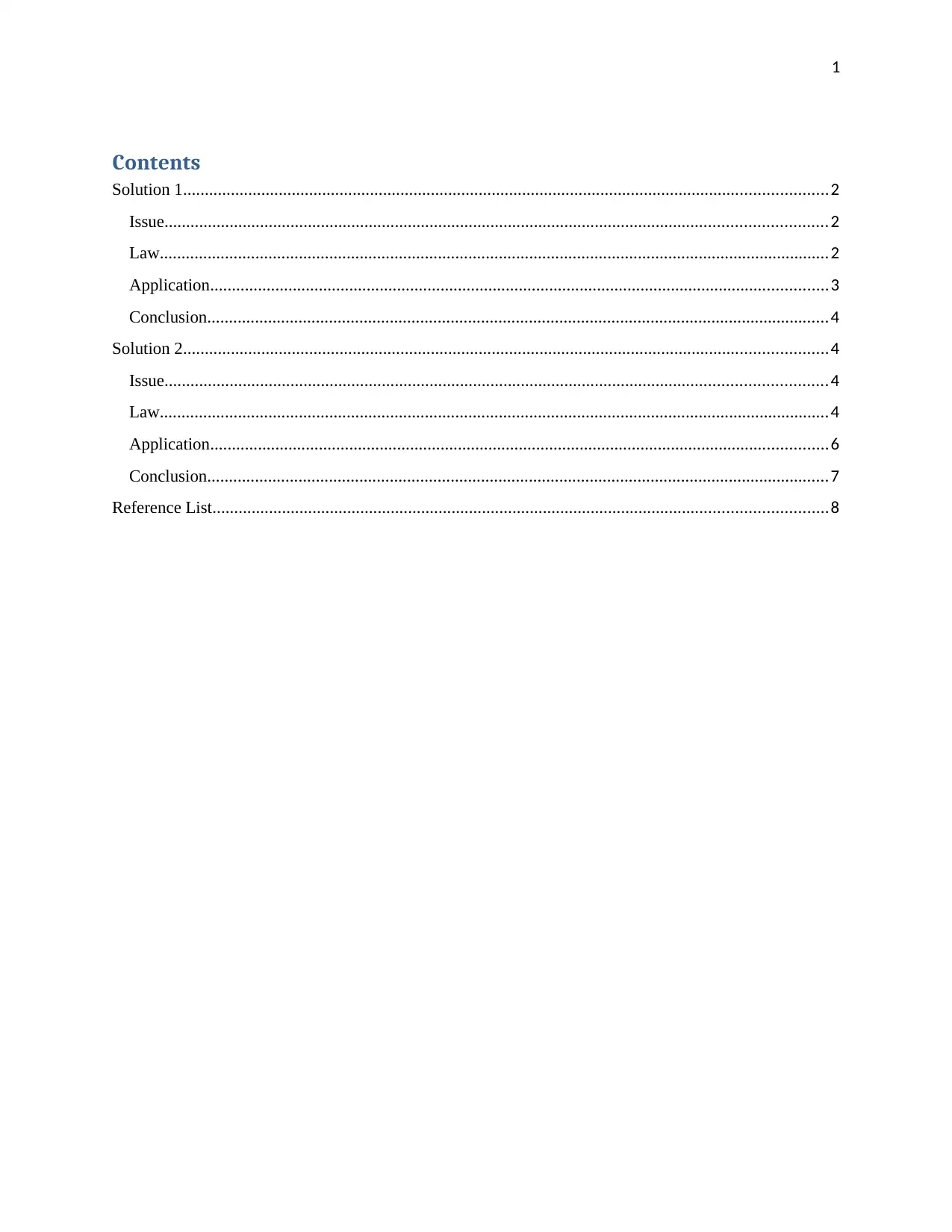
1
Contents
Solution 1....................................................................................................................................................2
Issue........................................................................................................................................................2
Law..........................................................................................................................................................2
Application..............................................................................................................................................3
Conclusion...............................................................................................................................................4
Solution 2....................................................................................................................................................4
Issue........................................................................................................................................................4
Law..........................................................................................................................................................4
Application..............................................................................................................................................6
Conclusion...............................................................................................................................................7
Reference List.............................................................................................................................................8
Contents
Solution 1....................................................................................................................................................2
Issue........................................................................................................................................................2
Law..........................................................................................................................................................2
Application..............................................................................................................................................3
Conclusion...............................................................................................................................................4
Solution 2....................................................................................................................................................4
Issue........................................................................................................................................................4
Law..........................................................................................................................................................4
Application..............................................................................................................................................6
Conclusion...............................................................................................................................................7
Reference List.............................................................................................................................................8
Paraphrase This Document
Need a fresh take? Get an instant paraphrase of this document with our AI Paraphraser
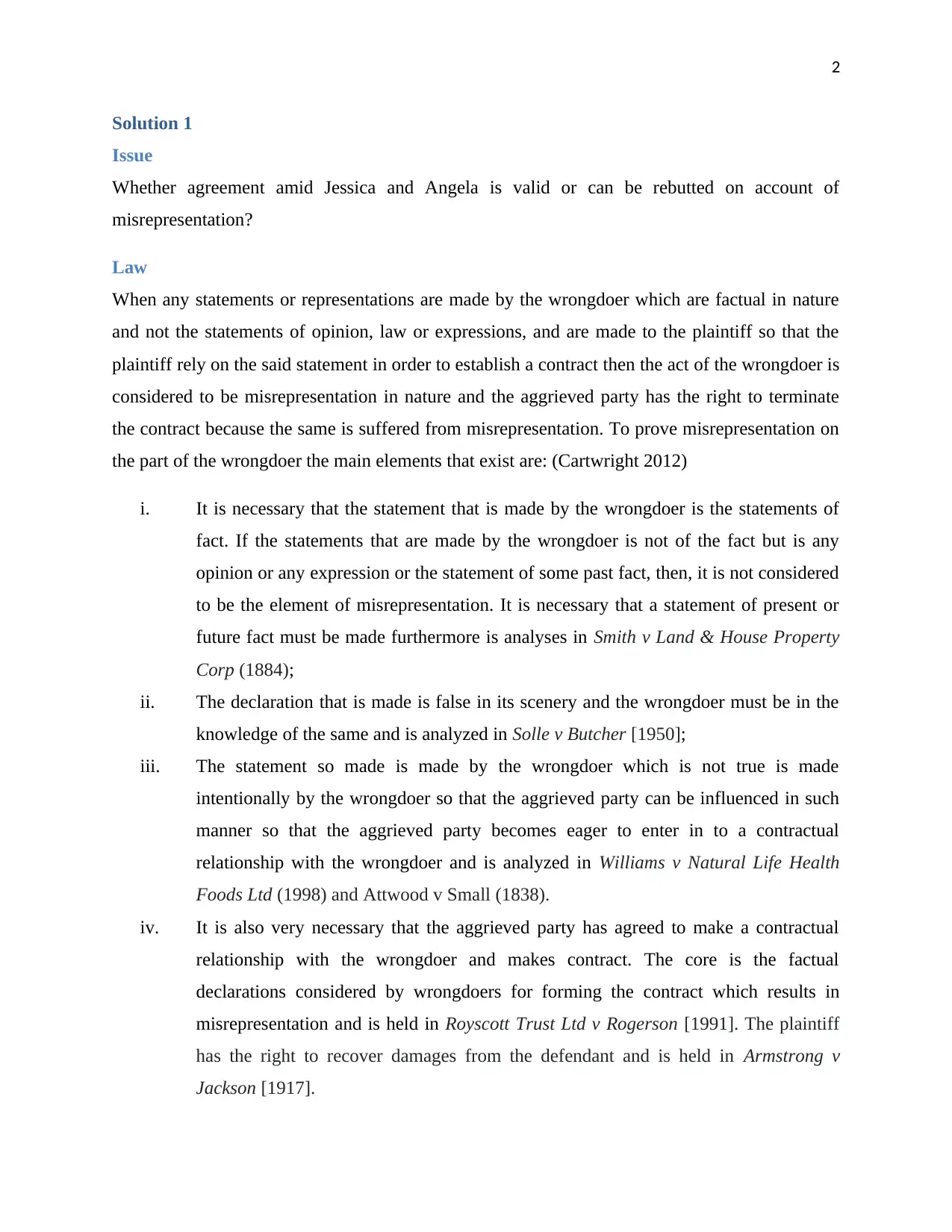
2
Solution 1
Issue
Whether agreement amid Jessica and Angela is valid or can be rebutted on account of
misrepresentation?
Law
When any statements or representations are made by the wrongdoer which are factual in nature
and not the statements of opinion, law or expressions, and are made to the plaintiff so that the
plaintiff rely on the said statement in order to establish a contract then the act of the wrongdoer is
considered to be misrepresentation in nature and the aggrieved party has the right to terminate
the contract because the same is suffered from misrepresentation. To prove misrepresentation on
the part of the wrongdoer the main elements that exist are: (Cartwright 2012)
i. It is necessary that the statement that is made by the wrongdoer is the statements of
fact. If the statements that are made by the wrongdoer is not of the fact but is any
opinion or any expression or the statement of some past fact, then, it is not considered
to be the element of misrepresentation. It is necessary that a statement of present or
future fact must be made furthermore is analyses in Smith v Land & House Property
Corp (1884);
ii. The declaration that is made is false in its scenery and the wrongdoer must be in the
knowledge of the same and is analyzed in Solle v Butcher [1950];
iii. The statement so made is made by the wrongdoer which is not true is made
intentionally by the wrongdoer so that the aggrieved party can be influenced in such
manner so that the aggrieved party becomes eager to enter in to a contractual
relationship with the wrongdoer and is analyzed in Williams v Natural Life Health
Foods Ltd (1998) and Attwood v Small (1838).
iv. It is also very necessary that the aggrieved party has agreed to make a contractual
relationship with the wrongdoer and makes contract. The core is the factual
declarations considered by wrongdoers for forming the contract which results in
misrepresentation and is held in Royscott Trust Ltd v Rogerson [1991]. The plaintiff
has the right to recover damages from the defendant and is held in Armstrong v
Jackson [1917].
Solution 1
Issue
Whether agreement amid Jessica and Angela is valid or can be rebutted on account of
misrepresentation?
Law
When any statements or representations are made by the wrongdoer which are factual in nature
and not the statements of opinion, law or expressions, and are made to the plaintiff so that the
plaintiff rely on the said statement in order to establish a contract then the act of the wrongdoer is
considered to be misrepresentation in nature and the aggrieved party has the right to terminate
the contract because the same is suffered from misrepresentation. To prove misrepresentation on
the part of the wrongdoer the main elements that exist are: (Cartwright 2012)
i. It is necessary that the statement that is made by the wrongdoer is the statements of
fact. If the statements that are made by the wrongdoer is not of the fact but is any
opinion or any expression or the statement of some past fact, then, it is not considered
to be the element of misrepresentation. It is necessary that a statement of present or
future fact must be made furthermore is analyses in Smith v Land & House Property
Corp (1884);
ii. The declaration that is made is false in its scenery and the wrongdoer must be in the
knowledge of the same and is analyzed in Solle v Butcher [1950];
iii. The statement so made is made by the wrongdoer which is not true is made
intentionally by the wrongdoer so that the aggrieved party can be influenced in such
manner so that the aggrieved party becomes eager to enter in to a contractual
relationship with the wrongdoer and is analyzed in Williams v Natural Life Health
Foods Ltd (1998) and Attwood v Small (1838).
iv. It is also very necessary that the aggrieved party has agreed to make a contractual
relationship with the wrongdoer and makes contract. The core is the factual
declarations considered by wrongdoers for forming the contract which results in
misrepresentation and is held in Royscott Trust Ltd v Rogerson [1991]. The plaintiff
has the right to recover damages from the defendant and is held in Armstrong v
Jackson [1917].
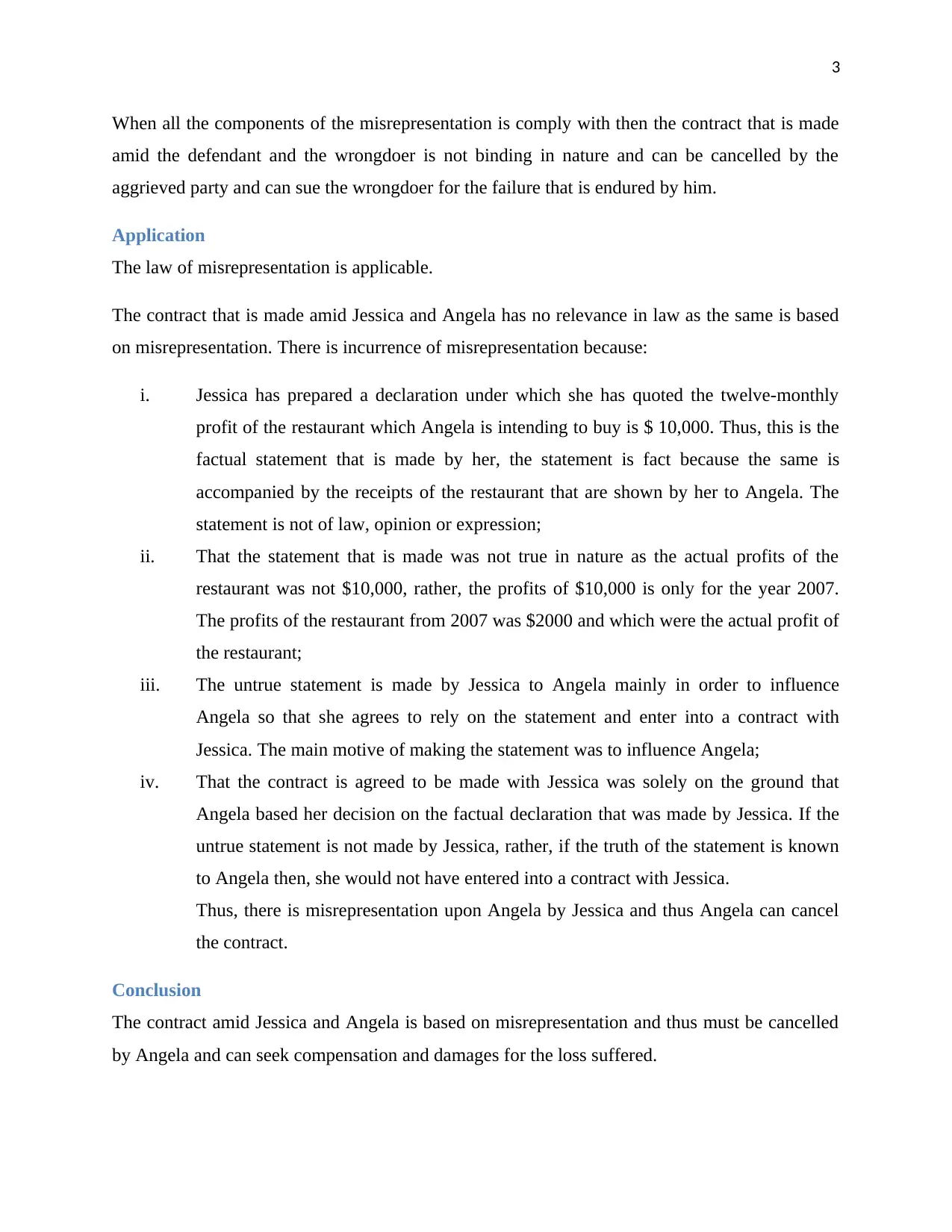
3
When all the components of the misrepresentation is comply with then the contract that is made
amid the defendant and the wrongdoer is not binding in nature and can be cancelled by the
aggrieved party and can sue the wrongdoer for the failure that is endured by him.
Application
The law of misrepresentation is applicable.
The contract that is made amid Jessica and Angela has no relevance in law as the same is based
on misrepresentation. There is incurrence of misrepresentation because:
i. Jessica has prepared a declaration under which she has quoted the twelve-monthly
profit of the restaurant which Angela is intending to buy is $ 10,000. Thus, this is the
factual statement that is made by her, the statement is fact because the same is
accompanied by the receipts of the restaurant that are shown by her to Angela. The
statement is not of law, opinion or expression;
ii. That the statement that is made was not true in nature as the actual profits of the
restaurant was not $10,000, rather, the profits of $10,000 is only for the year 2007.
The profits of the restaurant from 2007 was $2000 and which were the actual profit of
the restaurant;
iii. The untrue statement is made by Jessica to Angela mainly in order to influence
Angela so that she agrees to rely on the statement and enter into a contract with
Jessica. The main motive of making the statement was to influence Angela;
iv. That the contract is agreed to be made with Jessica was solely on the ground that
Angela based her decision on the factual declaration that was made by Jessica. If the
untrue statement is not made by Jessica, rather, if the truth of the statement is known
to Angela then, she would not have entered into a contract with Jessica.
Thus, there is misrepresentation upon Angela by Jessica and thus Angela can cancel
the contract.
Conclusion
The contract amid Jessica and Angela is based on misrepresentation and thus must be cancelled
by Angela and can seek compensation and damages for the loss suffered.
When all the components of the misrepresentation is comply with then the contract that is made
amid the defendant and the wrongdoer is not binding in nature and can be cancelled by the
aggrieved party and can sue the wrongdoer for the failure that is endured by him.
Application
The law of misrepresentation is applicable.
The contract that is made amid Jessica and Angela has no relevance in law as the same is based
on misrepresentation. There is incurrence of misrepresentation because:
i. Jessica has prepared a declaration under which she has quoted the twelve-monthly
profit of the restaurant which Angela is intending to buy is $ 10,000. Thus, this is the
factual statement that is made by her, the statement is fact because the same is
accompanied by the receipts of the restaurant that are shown by her to Angela. The
statement is not of law, opinion or expression;
ii. That the statement that is made was not true in nature as the actual profits of the
restaurant was not $10,000, rather, the profits of $10,000 is only for the year 2007.
The profits of the restaurant from 2007 was $2000 and which were the actual profit of
the restaurant;
iii. The untrue statement is made by Jessica to Angela mainly in order to influence
Angela so that she agrees to rely on the statement and enter into a contract with
Jessica. The main motive of making the statement was to influence Angela;
iv. That the contract is agreed to be made with Jessica was solely on the ground that
Angela based her decision on the factual declaration that was made by Jessica. If the
untrue statement is not made by Jessica, rather, if the truth of the statement is known
to Angela then, she would not have entered into a contract with Jessica.
Thus, there is misrepresentation upon Angela by Jessica and thus Angela can cancel
the contract.
Conclusion
The contract amid Jessica and Angela is based on misrepresentation and thus must be cancelled
by Angela and can seek compensation and damages for the loss suffered.
⊘ This is a preview!⊘
Do you want full access?
Subscribe today to unlock all pages.

Trusted by 1+ million students worldwide
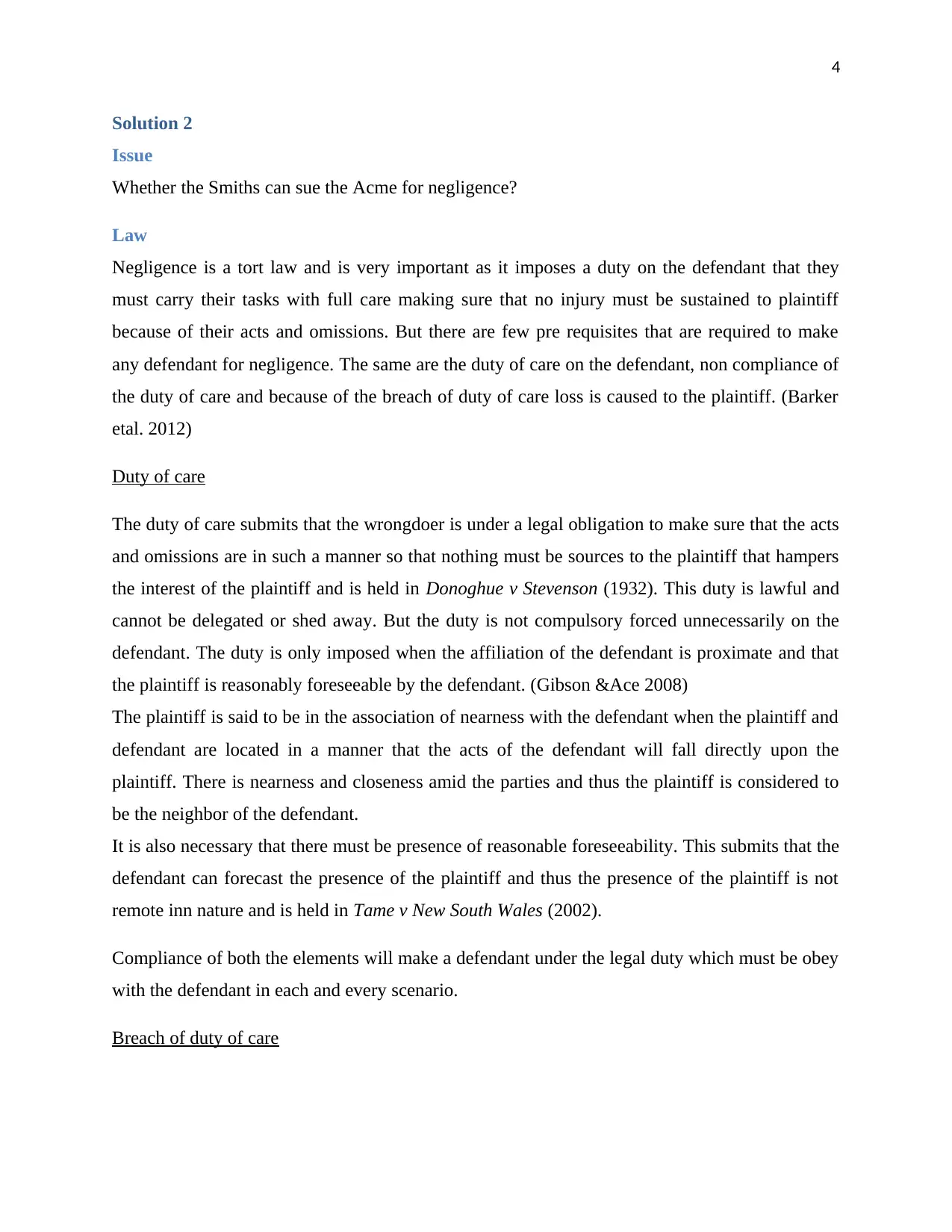
4
Solution 2
Issue
Whether the Smiths can sue the Acme for negligence?
Law
Negligence is a tort law and is very important as it imposes a duty on the defendant that they
must carry their tasks with full care making sure that no injury must be sustained to plaintiff
because of their acts and omissions. But there are few pre requisites that are required to make
any defendant for negligence. The same are the duty of care on the defendant, non compliance of
the duty of care and because of the breach of duty of care loss is caused to the plaintiff. (Barker
etal. 2012)
Duty of care
The duty of care submits that the wrongdoer is under a legal obligation to make sure that the acts
and omissions are in such a manner so that nothing must be sources to the plaintiff that hampers
the interest of the plaintiff and is held in Donoghue v Stevenson (1932). This duty is lawful and
cannot be delegated or shed away. But the duty is not compulsory forced unnecessarily on the
defendant. The duty is only imposed when the affiliation of the defendant is proximate and that
the plaintiff is reasonably foreseeable by the defendant. (Gibson &Ace 2008)
The plaintiff is said to be in the association of nearness with the defendant when the plaintiff and
defendant are located in a manner that the acts of the defendant will fall directly upon the
plaintiff. There is nearness and closeness amid the parties and thus the plaintiff is considered to
be the neighbor of the defendant.
It is also necessary that there must be presence of reasonable foreseeability. This submits that the
defendant can forecast the presence of the plaintiff and thus the presence of the plaintiff is not
remote inn nature and is held in Tame v New South Wales (2002).
Compliance of both the elements will make a defendant under the legal duty which must be obey
with the defendant in each and every scenario.
Breach of duty of care
Solution 2
Issue
Whether the Smiths can sue the Acme for negligence?
Law
Negligence is a tort law and is very important as it imposes a duty on the defendant that they
must carry their tasks with full care making sure that no injury must be sustained to plaintiff
because of their acts and omissions. But there are few pre requisites that are required to make
any defendant for negligence. The same are the duty of care on the defendant, non compliance of
the duty of care and because of the breach of duty of care loss is caused to the plaintiff. (Barker
etal. 2012)
Duty of care
The duty of care submits that the wrongdoer is under a legal obligation to make sure that the acts
and omissions are in such a manner so that nothing must be sources to the plaintiff that hampers
the interest of the plaintiff and is held in Donoghue v Stevenson (1932). This duty is lawful and
cannot be delegated or shed away. But the duty is not compulsory forced unnecessarily on the
defendant. The duty is only imposed when the affiliation of the defendant is proximate and that
the plaintiff is reasonably foreseeable by the defendant. (Gibson &Ace 2008)
The plaintiff is said to be in the association of nearness with the defendant when the plaintiff and
defendant are located in a manner that the acts of the defendant will fall directly upon the
plaintiff. There is nearness and closeness amid the parties and thus the plaintiff is considered to
be the neighbor of the defendant.
It is also necessary that there must be presence of reasonable foreseeability. This submits that the
defendant can forecast the presence of the plaintiff and thus the presence of the plaintiff is not
remote inn nature and is held in Tame v New South Wales (2002).
Compliance of both the elements will make a defendant under the legal duty which must be obey
with the defendant in each and every scenario.
Breach of duty of care
Paraphrase This Document
Need a fresh take? Get an instant paraphrase of this document with our AI Paraphraser
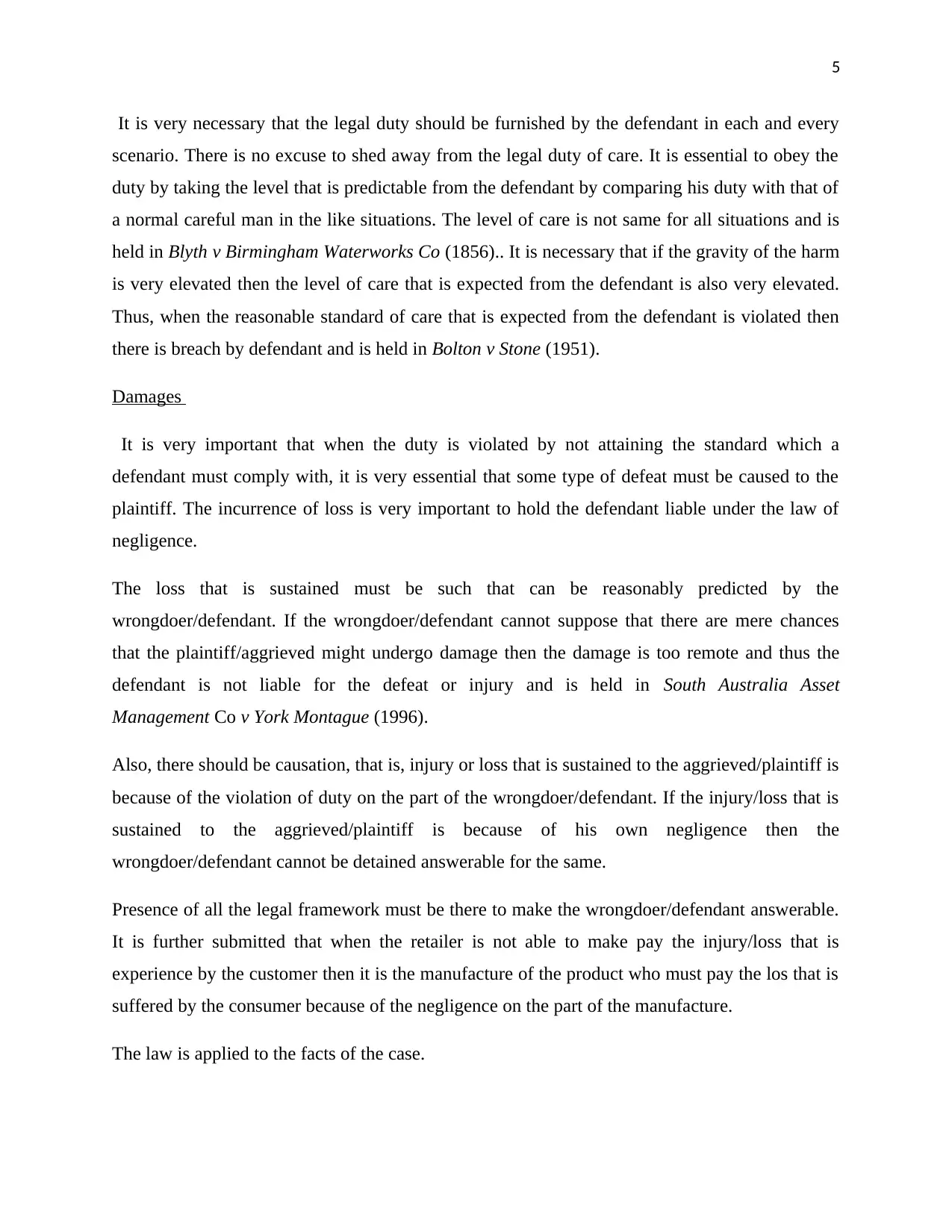
5
It is very necessary that the legal duty should be furnished by the defendant in each and every
scenario. There is no excuse to shed away from the legal duty of care. It is essential to obey the
duty by taking the level that is predictable from the defendant by comparing his duty with that of
a normal careful man in the like situations. The level of care is not same for all situations and is
held in Blyth v Birmingham Waterworks Co (1856).. It is necessary that if the gravity of the harm
is very elevated then the level of care that is expected from the defendant is also very elevated.
Thus, when the reasonable standard of care that is expected from the defendant is violated then
there is breach by defendant and is held in Bolton v Stone (1951).
Damages
It is very important that when the duty is violated by not attaining the standard which a
defendant must comply with, it is very essential that some type of defeat must be caused to the
plaintiff. The incurrence of loss is very important to hold the defendant liable under the law of
negligence.
The loss that is sustained must be such that can be reasonably predicted by the
wrongdoer/defendant. If the wrongdoer/defendant cannot suppose that there are mere chances
that the plaintiff/aggrieved might undergo damage then the damage is too remote and thus the
defendant is not liable for the defeat or injury and is held in South Australia Asset
Management Co v York Montague (1996).
Also, there should be causation, that is, injury or loss that is sustained to the aggrieved/plaintiff is
because of the violation of duty on the part of the wrongdoer/defendant. If the injury/loss that is
sustained to the aggrieved/plaintiff is because of his own negligence then the
wrongdoer/defendant cannot be detained answerable for the same.
Presence of all the legal framework must be there to make the wrongdoer/defendant answerable.
It is further submitted that when the retailer is not able to make pay the injury/loss that is
experience by the customer then it is the manufacture of the product who must pay the los that is
suffered by the consumer because of the negligence on the part of the manufacture.
The law is applied to the facts of the case.
It is very necessary that the legal duty should be furnished by the defendant in each and every
scenario. There is no excuse to shed away from the legal duty of care. It is essential to obey the
duty by taking the level that is predictable from the defendant by comparing his duty with that of
a normal careful man in the like situations. The level of care is not same for all situations and is
held in Blyth v Birmingham Waterworks Co (1856).. It is necessary that if the gravity of the harm
is very elevated then the level of care that is expected from the defendant is also very elevated.
Thus, when the reasonable standard of care that is expected from the defendant is violated then
there is breach by defendant and is held in Bolton v Stone (1951).
Damages
It is very important that when the duty is violated by not attaining the standard which a
defendant must comply with, it is very essential that some type of defeat must be caused to the
plaintiff. The incurrence of loss is very important to hold the defendant liable under the law of
negligence.
The loss that is sustained must be such that can be reasonably predicted by the
wrongdoer/defendant. If the wrongdoer/defendant cannot suppose that there are mere chances
that the plaintiff/aggrieved might undergo damage then the damage is too remote and thus the
defendant is not liable for the defeat or injury and is held in South Australia Asset
Management Co v York Montague (1996).
Also, there should be causation, that is, injury or loss that is sustained to the aggrieved/plaintiff is
because of the violation of duty on the part of the wrongdoer/defendant. If the injury/loss that is
sustained to the aggrieved/plaintiff is because of his own negligence then the
wrongdoer/defendant cannot be detained answerable for the same.
Presence of all the legal framework must be there to make the wrongdoer/defendant answerable.
It is further submitted that when the retailer is not able to make pay the injury/loss that is
experience by the customer then it is the manufacture of the product who must pay the los that is
suffered by the consumer because of the negligence on the part of the manufacture.
The law is applied to the facts of the case.
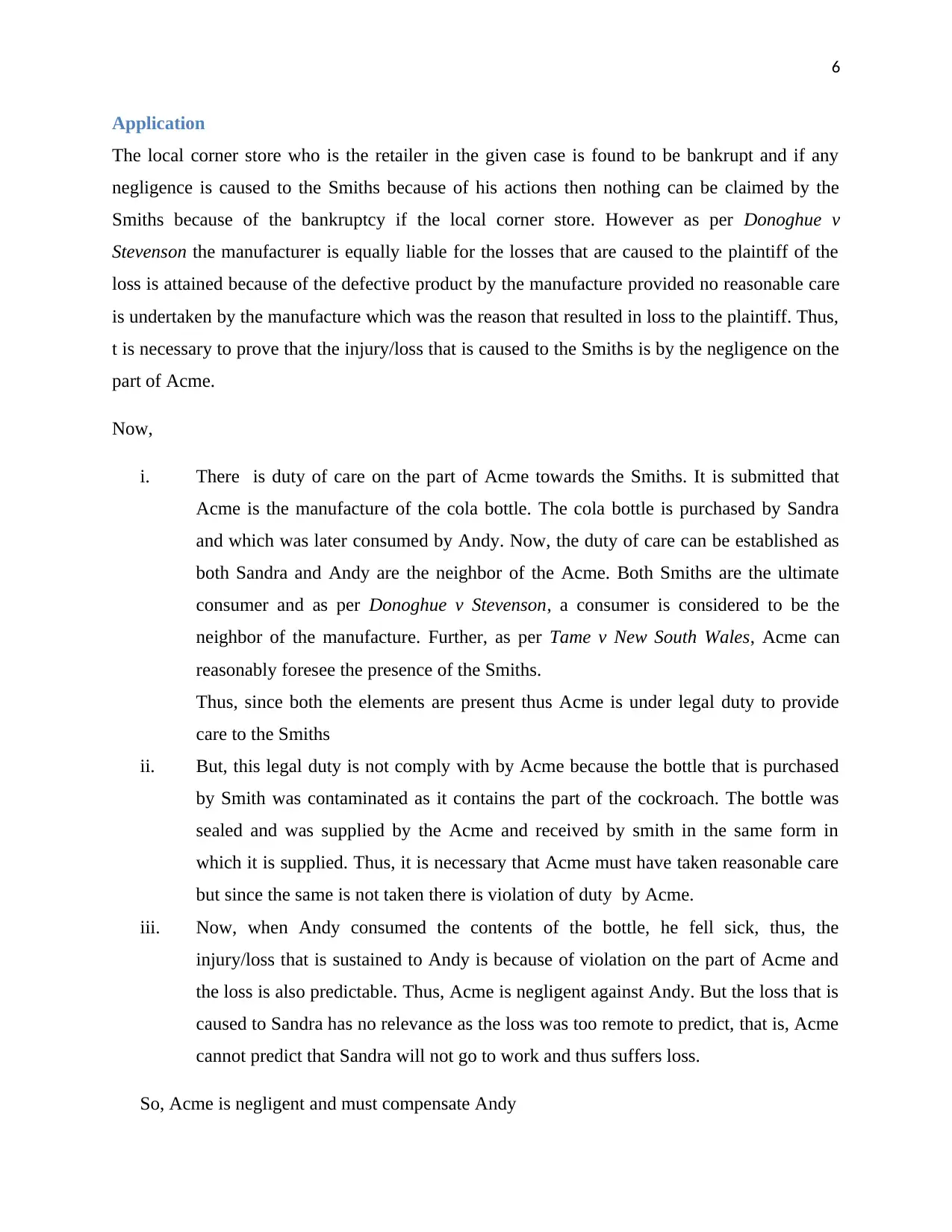
6
Application
The local corner store who is the retailer in the given case is found to be bankrupt and if any
negligence is caused to the Smiths because of his actions then nothing can be claimed by the
Smiths because of the bankruptcy if the local corner store. However as per Donoghue v
Stevenson the manufacturer is equally liable for the losses that are caused to the plaintiff of the
loss is attained because of the defective product by the manufacture provided no reasonable care
is undertaken by the manufacture which was the reason that resulted in loss to the plaintiff. Thus,
t is necessary to prove that the injury/loss that is caused to the Smiths is by the negligence on the
part of Acme.
Now,
i. There is duty of care on the part of Acme towards the Smiths. It is submitted that
Acme is the manufacture of the cola bottle. The cola bottle is purchased by Sandra
and which was later consumed by Andy. Now, the duty of care can be established as
both Sandra and Andy are the neighbor of the Acme. Both Smiths are the ultimate
consumer and as per Donoghue v Stevenson, a consumer is considered to be the
neighbor of the manufacture. Further, as per Tame v New South Wales, Acme can
reasonably foresee the presence of the Smiths.
Thus, since both the elements are present thus Acme is under legal duty to provide
care to the Smiths
ii. But, this legal duty is not comply with by Acme because the bottle that is purchased
by Smith was contaminated as it contains the part of the cockroach. The bottle was
sealed and was supplied by the Acme and received by smith in the same form in
which it is supplied. Thus, it is necessary that Acme must have taken reasonable care
but since the same is not taken there is violation of duty by Acme.
iii. Now, when Andy consumed the contents of the bottle, he fell sick, thus, the
injury/loss that is sustained to Andy is because of violation on the part of Acme and
the loss is also predictable. Thus, Acme is negligent against Andy. But the loss that is
caused to Sandra has no relevance as the loss was too remote to predict, that is, Acme
cannot predict that Sandra will not go to work and thus suffers loss.
So, Acme is negligent and must compensate Andy
Application
The local corner store who is the retailer in the given case is found to be bankrupt and if any
negligence is caused to the Smiths because of his actions then nothing can be claimed by the
Smiths because of the bankruptcy if the local corner store. However as per Donoghue v
Stevenson the manufacturer is equally liable for the losses that are caused to the plaintiff of the
loss is attained because of the defective product by the manufacture provided no reasonable care
is undertaken by the manufacture which was the reason that resulted in loss to the plaintiff. Thus,
t is necessary to prove that the injury/loss that is caused to the Smiths is by the negligence on the
part of Acme.
Now,
i. There is duty of care on the part of Acme towards the Smiths. It is submitted that
Acme is the manufacture of the cola bottle. The cola bottle is purchased by Sandra
and which was later consumed by Andy. Now, the duty of care can be established as
both Sandra and Andy are the neighbor of the Acme. Both Smiths are the ultimate
consumer and as per Donoghue v Stevenson, a consumer is considered to be the
neighbor of the manufacture. Further, as per Tame v New South Wales, Acme can
reasonably foresee the presence of the Smiths.
Thus, since both the elements are present thus Acme is under legal duty to provide
care to the Smiths
ii. But, this legal duty is not comply with by Acme because the bottle that is purchased
by Smith was contaminated as it contains the part of the cockroach. The bottle was
sealed and was supplied by the Acme and received by smith in the same form in
which it is supplied. Thus, it is necessary that Acme must have taken reasonable care
but since the same is not taken there is violation of duty by Acme.
iii. Now, when Andy consumed the contents of the bottle, he fell sick, thus, the
injury/loss that is sustained to Andy is because of violation on the part of Acme and
the loss is also predictable. Thus, Acme is negligent against Andy. But the loss that is
caused to Sandra has no relevance as the loss was too remote to predict, that is, Acme
cannot predict that Sandra will not go to work and thus suffers loss.
So, Acme is negligent and must compensate Andy
⊘ This is a preview!⊘
Do you want full access?
Subscribe today to unlock all pages.

Trusted by 1+ million students worldwide
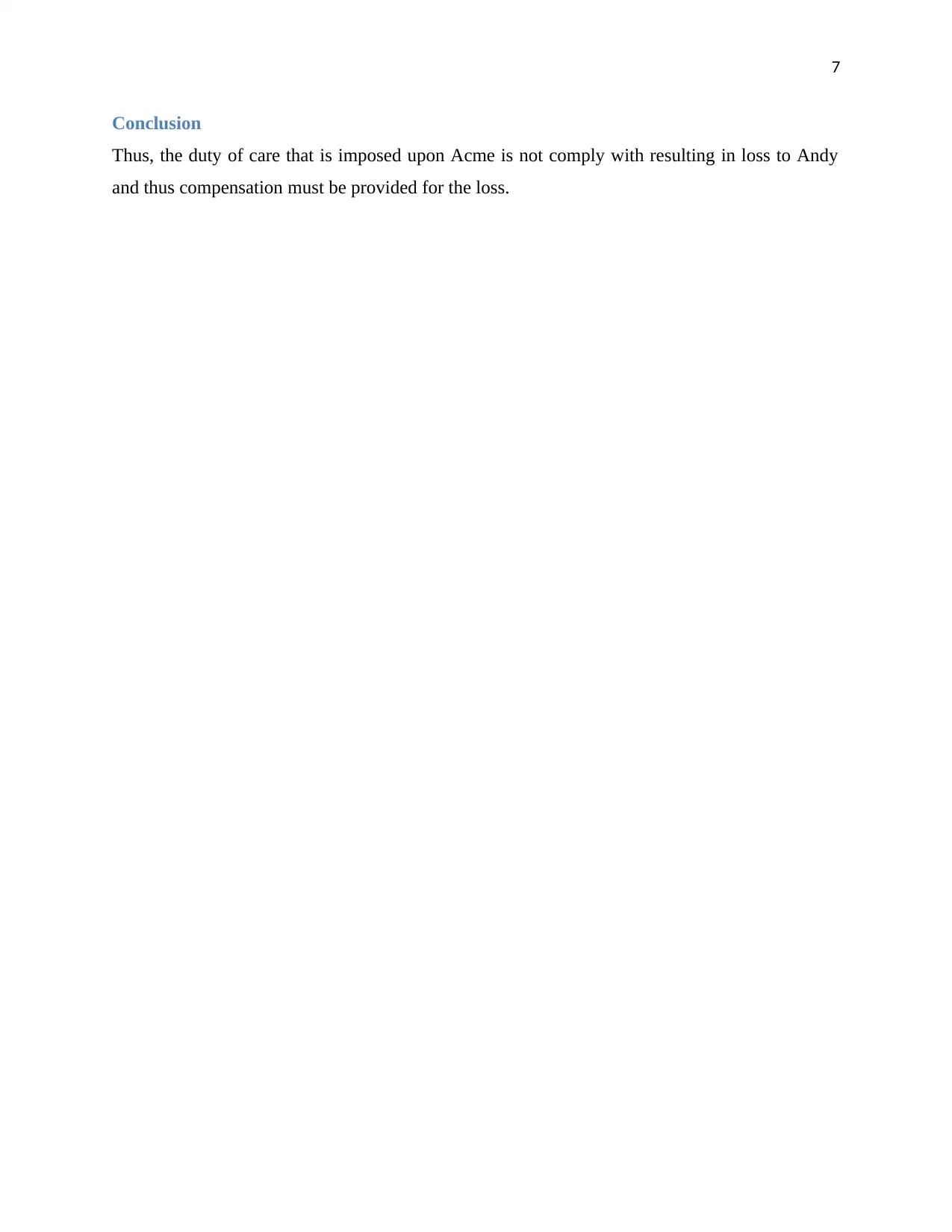
7
Conclusion
Thus, the duty of care that is imposed upon Acme is not comply with resulting in loss to Andy
and thus compensation must be provided for the loss.
Conclusion
Thus, the duty of care that is imposed upon Acme is not comply with resulting in loss to Andy
and thus compensation must be provided for the loss.
Paraphrase This Document
Need a fresh take? Get an instant paraphrase of this document with our AI Paraphraser
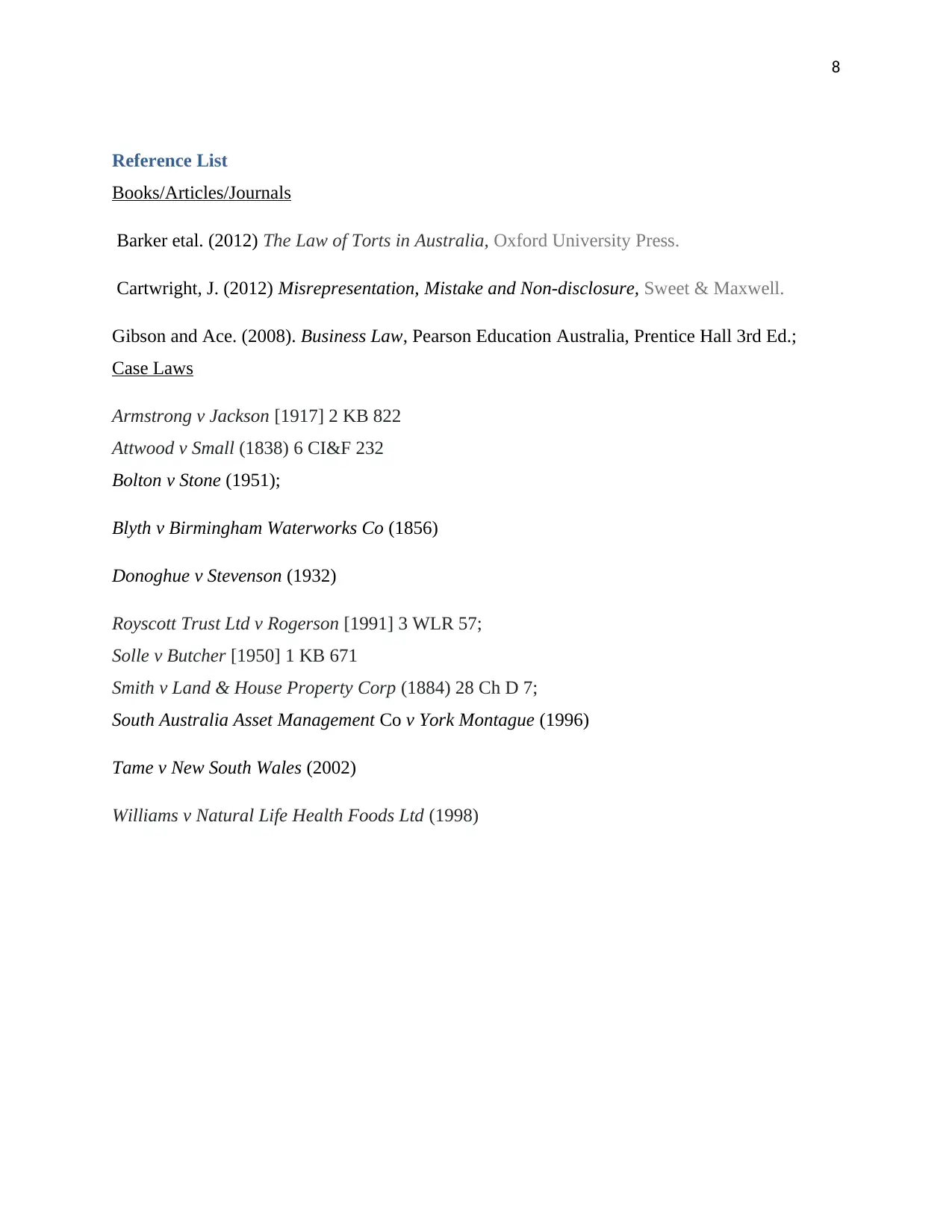
8
Reference List
Books/Articles/Journals
Barker etal. (2012) The Law of Torts in Australia, Oxford University Press.
Cartwright, J. (2012) Misrepresentation, Mistake and Non-disclosure, Sweet & Maxwell.
Gibson and Ace. (2008). Business Law, Pearson Education Australia, Prentice Hall 3rd Ed.;
Case Laws
Armstrong v Jackson [1917] 2 KB 822
Attwood v Small (1838) 6 CI&F 232
Bolton v Stone (1951);
Blyth v Birmingham Waterworks Co (1856)
Donoghue v Stevenson (1932)
Royscott Trust Ltd v Rogerson [1991] 3 WLR 57;
Solle v Butcher [1950] 1 KB 671
Smith v Land & House Property Corp (1884) 28 Ch D 7;
South Australia Asset Management Co v York Montague (1996)
Tame v New South Wales (2002)
Williams v Natural Life Health Foods Ltd (1998)
Reference List
Books/Articles/Journals
Barker etal. (2012) The Law of Torts in Australia, Oxford University Press.
Cartwright, J. (2012) Misrepresentation, Mistake and Non-disclosure, Sweet & Maxwell.
Gibson and Ace. (2008). Business Law, Pearson Education Australia, Prentice Hall 3rd Ed.;
Case Laws
Armstrong v Jackson [1917] 2 KB 822
Attwood v Small (1838) 6 CI&F 232
Bolton v Stone (1951);
Blyth v Birmingham Waterworks Co (1856)
Donoghue v Stevenson (1932)
Royscott Trust Ltd v Rogerson [1991] 3 WLR 57;
Solle v Butcher [1950] 1 KB 671
Smith v Land & House Property Corp (1884) 28 Ch D 7;
South Australia Asset Management Co v York Montague (1996)
Tame v New South Wales (2002)
Williams v Natural Life Health Foods Ltd (1998)
1 out of 8
Related Documents
Your All-in-One AI-Powered Toolkit for Academic Success.
+13062052269
info@desklib.com
Available 24*7 on WhatsApp / Email
![[object Object]](/_next/static/media/star-bottom.7253800d.svg)
Unlock your academic potential
Copyright © 2020–2025 A2Z Services. All Rights Reserved. Developed and managed by ZUCOL.





